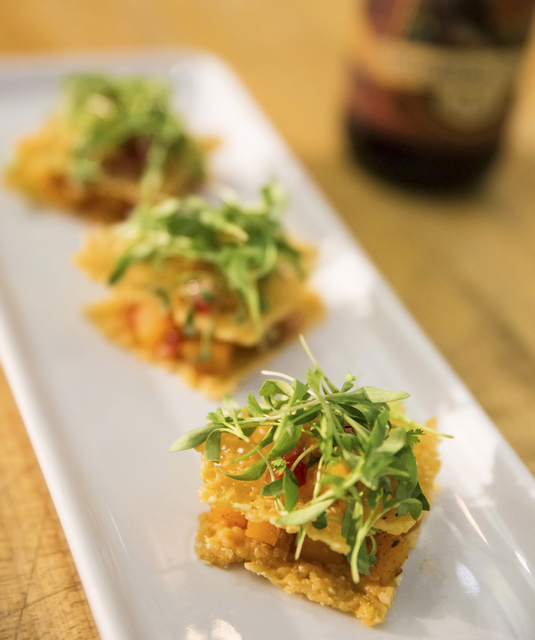Pomegranate’s ‘pop’ of tangy flavor worth the hassle of preparation
It’s not unusual for chefs to sound downright poetic when they’re talking about favorite foods, but in his recent newsletter, chef Charlie Palmer clearly was inspired to even greater heights.
Summer, Palmer wrote, “went out in a blaze of glory. I am talking about the pomegranate — that ruby-colored globe protecting hundreds of seeds, plump and juicy — like fruit caviar.”
They are indeed like fruit caviar, and they’re in season and inspiring chefs to introduce pomegranate-showcasing dishes such as the salad of burrata with pomegranates, endive and a beet vinaigrette at Charlie Palmer Steak at the Four Seasons.
“The chunk of burrata kind of creates a little nest,” said Thomas Griese, the restaurant’s executive chef. “It’s amazing.”
Griese said he has an appreciation for pomegranate seeds, also known as arils.
“They provide a crunch,” he said. “Not only a textural standpoint, but acid and sweetness. You get that little ‘pop’ that comes out when you crunch down on it. It really provides a lot of good balance to dishes.”
“They’re good with fowl; they’re really good with duck,” said Tony Mangione, vice president of food and beverage for Station Casinos. “They’re good with desserts. You can make almost anything. It goes savory or sweet. I eat mine right out of the shell. If you want, put the seeds in an ice bath, put them in the refrigerator for about 20 minutes, then drain them off and they’re really crunchy.”
“I generally use them to add texture,” said Charles Miller, executive chef of the House of Blues at Mandalay Bay. “It kind of adds a little ‘pop,’ and then you get a little sweetness and a little tartness.” For a beer dinner, he’s making quesadillas filled with butternut squash studded with pomegranate seeds.
He noted pomegranates have been recognized for potential health benefits. According to the National Institutes of Health, they may help ward off infections, may be useful in the prevention of prostate cancer and may help improve some signs of heart disease.
Miller said he also likes to use pomegranate juice and syrup (sometimes called pomegranate molasses). He may use juice in place of braising liquids, or uses the syrup as a soup garnish or to build cocktails.
Packages of arils are available in local supermarkets, because cleaning a pomegranate can be a bit of a challenge.
“The thing about them is they’re very messy to handle,” Mangione said. “I’ve ruined many a garment.”
Opinion as to the best method is greatly divided; although there are several pomegranate-seeding gadgets on the market, these chefs do it the old-fashioned way(s).
Mangione likes to take out the top crown, score the skin about eight times and then pull apart the seeds, preferably over the sink.
“You don’t wear something that you like,” he said. “You better put a bib on. There’s no way out of it. And then your fingers will be pink for a while.”
Griese likes to deflect the juice.
“The best way to clean them,” he said, “is you cut them in half. Hold it so the seeds are facing down, then take the back of a spoon and you kind of want to beat the top of the peel so the seeds fall out.” He suggests doing it over a large mixing bowl containing a shallow amount of water.
“If you get some of the pith, that will float to the top and the seeds will fall to the bottom,” he said. “It’s a little less messy as well. If you do it over a cutting board or plate, it’ll be a mess.”
Miller moves the whole process underwater. After removing the crown, he said, score just the outer skin and then start to break apart the pomegranate, all while it’s submerged. The membranes will float to the top, seeds sink to the bottom. Then, Miller said, drain the seeds, let them dry a bit and spread them in a single layer in a sheet pan in the freezer.
“And when they’re frozen, you can put them in a bag and hold those for later,” he said.
Whichever method you use, they said the pomegranate is worth the trouble.
“I think it’s underestimated in the culinary world,” Griese said. “It can create a lot of balance. And it’s a fun food.”
RICE AND PASTA PILAF WITH POMEGRANATE AND WALNUTS
1½ cups basmati rice or long-grain white rice
3 tablespoons unsalted butter
2 ounces vermicelli, broken into 1-inch pieces
2 tablespoons grated fresh ginger
2½ cups chicken broth
1¼ teaspoons salt
½ teaspoon ground cumin
½ cup walnuts, toasted and coarsely chopped
½ cup pomegranate seeds
½ cup chopped fresh cilantro
1 tablespoon lemon juice
Place rice in medium bowl and cover with hot tap water by 2 inches; let stand for 15 minutes.
Using your hands, gently swish grains to release excess starch. Carefully pour off water, leaving rice in bowl. Add cold tap water to rice and pour off water. Repeat adding and pouring off water four to five times, until water runs almost clear. Drain rice in fine-mesh strainer.
Melt butter in large saucepan over medium heat. Add pasta and cook, stirring occasionally, until browned, about 3 minutes. Add ginger and rice and cook, stirring occasionally, until edges of rice begin to turn translucent, about 3 minutes. Add broth, salt and cumin and bring to boil. Reduce heat to low, cover and cook until all liquid is absorbed, about 10 minutes. Off heat, remove lid, fold dish towel in half and place over pan; replace lid. Let stand for 10 minutes. Fluff rice with fork; stir in walnuts, pomegranate seeds, cilantro and lemon juice and serve.
Serves 4 to 6 as a side dish.
— Cook’s Illustrated
CRANBERRY POMEGRANATE SAUCE
1 12-ounce bag cranberries, thawed if frozen
½ cup packed light brown sugar
¼ cup pomegranate molasses (see notes)
3 small sprigs fresh thyme
1 cup pomegranate seeds
In a medium saucepan, bring cranberries, sugar, molasses and thyme to a boil over medium-high heat, stirring frequently. Boil, stirring often, until most cranberries pop, 5 minutes. Remove from heat and stir in pomegranate seeds. Discard thyme.
Notes: Available at well-stocked supermarkets and Middle Eastern grocery stores. To make ahead, chill cooked cranberries, covered, as long as 1 week; add pomegranate seeds just before serving.
Serves 12.
— Sunset magazine
POMEGRANATE CHICKEN
1 teaspoon olive oil
2 tablespoons minced shallots
½ teaspoon chopped fresh rosemary
1 cup pomegranate juice
¼ cup agave nectar
2 tablespoons red wine vinegar
1 tablespoon butter
1 tablespoon olive oil
4 (6-ounce) skinless, boneless chicken breast halves
¼ teaspoon salt
¼ teaspoon black pepper
Pomegranate arils for garnish
Heat a small saucepan over medium-high heat. Add 1 teaspoon olive oil; swirl. Add shallots and fresh rosemary; saute 1 minute. Stir in pomegranate juice, agave nectar and red wine vinegar; bring to a boil. Cook until reduced to 1/2 cup (about 15 minutes), stirring occasionally. Remove from heat; stir in butter.
Heat a large skillet over medium-high heat. Add 1 tablespoon olive oil; swirl. Sprinkle chicken with ¼ teaspoon salt and ¼ teaspoon black pepper. Add chicken to pan; saute 4 minutes on each side or until browned. Brush chicken with ¼ cup glaze; cook 1 minute. Turn chicken over; brush with remaining glaze. Cook 1 minute or until chicken is done. Garnish, if desired.
Serves 4.
— Cooking Light
Contact Heidi Knapp Rinella at Hrinella@reviewjournal.com. Find more of her stories at www.reviewjournal.com, and follow @HKRinella on Twitter.
Pomegranate Festival
The Moapa Valley Art Guild's 21st Pomegranate Festival is from 9 a.m to 4 p.m. Friday and Saturday at the Clark County Fairgrounds in Logandale. On hand will be several kinds of pomegranate jelly, juice, pomegranate honey and syrup and fresh pomegranates.
Food booths also will offer kielbasa, hot dogs, hamburgers, sandwiches, Mexican food, teriyaki bowls, baked potatoes, roasted corn, flavored lemonade and frozen yogurt.
Some 80 artists' booths will feature gourds, ceramics, sculpture, woodworking, metalwork, quilts and other handmade items.
Admission is free.
































